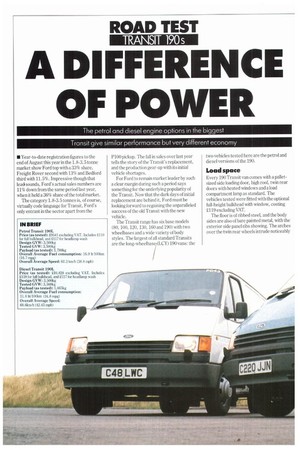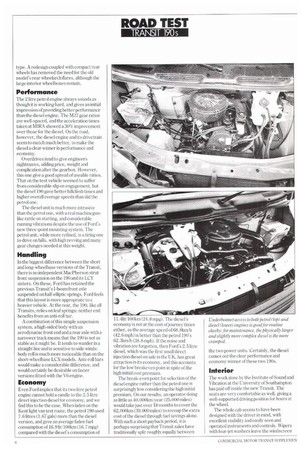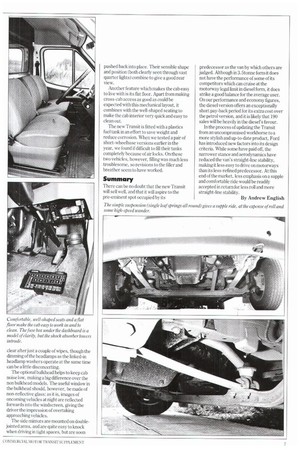A DIFFER NC OF POW
Page 104

Page 105

Page 106

Page 107

If you've noticed an error in this article please click here to report it so we can fix it.
The petrol and diesel engine options in the biggest Transit give similar performance but very different economy
• Year-to-date registration figures to the end of August this year in the 1.8-3.5 tonne market show Ford top with a 33% share, Freight Rover second with 13% and Bedford third with 11.5%. Impressive though that leadsounds, Ford's actual sales numbers are 11% down from the same period last year, when it held a 36% share of the total market.
The category 1.8-3.5 tonnes is, of course, virtually code language for Transit, Ford's only entrant in the sector apart from the P100 pickup. The fall in sales over last year tells the story of the Transit's replacement, and the production gear-up with its initial vehicle shortages.
For Ford to remain market leader by such a clear margin during such a period says something for the underlying popularity of the Transit. Now that the dark days of initial replacement are behind it, Ford must be looking forward to regaining the unparalleled success of the old Transit with the new vehicle.
The Transit range has six base models (80, 100, 120, 130, 160 and 190) with two wheelbases and a wide variety of body styles. The largest of all standard Transits are the long-wheelbase/ (LC Y) 190 vans: the two vehicles tested here are the petrol and diesel versions of the 190.
Load space
Every 190 Transit van comes with a palletsized side loading door, high roof, twin rear doors with heated windows and a load compartment lamp as standard. The vehicles tested were fitted with the optional full-height bulkhead with window, costing .119 excluding VAT.
The floor is of ribbed steel, and the body sides are also of bare painted metal, with the exterior side panel ribs showing. The arches over the twin rear wheels intrude noticeably into the load space, robbing a total of 537mm from the interior width: they are flat-topped. The floor is cut away at the sides to provide a step for the side loading door.
Loading more than 1.5 tonnes (even of Commercial Motor's 15kg weights) into any vehicle is hard work, and the provision of a side loading door is a welcome addition, especially where a forklift truck is available and the door (as on the Transit) is large enough to accommodate them.
The loadspace volume of the Transit, at 8. 4rri4 is larger than that of the Volkswagen LT35, though the Ford's high roof provides little compensation for the space-hungry rear wheel housings and rear drive. The front-wheel-drive Renault Master is much more voluminous at 9. 05m3.
The Transit's payload of 1, 788kg for the petrol version and 1, 665kg for the diesel shows that although Ford has used advanced finite element analysis techniques in designing the body, it has not produced results (on paper) very different from those of the opposition. In our selected comparisons, the Transit shows up as neither particularly good nor bad. The real benefits should, of course, show up in the durability of the newer design compared with earlier ones.
Most of the interior fittings are of plastics, and we felt that the left-hand rear interior door handle, in particular, could prove flimsy with repeated use — as well as trapping users' fingers because of its positioning.
Driveline
Like the Mercedes-Benz 307D, the Transit has its engine forward of the driver, with access for routine servicing through a front bonnet. The 190 is offered with a choice of 2 litre overhead camshaft petrol or 2.5 litre direct injection diesel engines. These are the prinicpal engines available in the entire Transit range, and are tried and tested from their installation in the old model. The elderly 3 litre petrol V6 is now entering production as a special option (popular with police and ambulance services) and there is a smaller 1.6 litre OHC petrol engine available in 80 and 100 models. Routine access to both units is good, but major work might require engine removal.
The petrol 190 is fitted with Ford's M27 five-speed gearbox, with reverse and fifth gear positions arranged on each side of a conventional four-speed '11' pattern gate. The diesel version, with its greater torque, has the older M26 four-speed gearbox, available with a Laycock electricallyengaged overdrive which can be operated on third and fourth gears. The overdrive switch is mounted in the top of the gear lever, down the outside of which the wires run, in a vulnerable position which might not make sense considering the prevalence of electrical malfunctions over all other failings on this type of overdrive.
The rear axle is Ford's heavy-duty S310. type. A redesign coupled with compact rear wheels has removed the need for the old model's rear wheelarch flares, although the large interior wheelboxes remain.
Perionnance
The 2 litre petrol engine always sounds as though it is working hard, and gives an initial impression of providing better performance than the diesel engine. The M27 gear ratios are well-spaced, and the acceleration times taken at MIRA showed a 30% improvement over those for the diesel. On the road, however, the diesel engine and its drivetrain seem to match much better, to make the diesel a clear winner in performance and economy.
Overdrives tend to give engineers nightmares, adding price, weight and complication after the gearbox. However, this one give a good spread of useable ratios. That on the test vehicle seemed to suffer from considerable slip on engagement, but the diesel 190 gave better hillclimb times and higher overall average speeds than did the petrol one.
The diesel unit is much more intrusive than the petrol one, with a real machinegunlike rattle on starting, and considerable running vibrations despite the use of Ford's new three-point mounting system. The petrol unit, while more refined, is a tiring one to drive on hills, with high revving and many gear changes needed at this weight.
Handling
In the biggest difference between the short and long-wheelbase versions of the Transit, there is no independent MacPherson strut front suspension on the 190 and its LCY sisters. On these, Ford has retained the previous Transit's I-beam front axle suspended on half-elliptic springs. Ford feels that this layout is more appropriate to a heavier vehicle. At the rear, the 190, like all Transits, relies on leaf springs: neither end benefits from an anti-roll bar.
A combination of this simple suspension system, a high-sided body with an aerodynamic front end and a rear axle with a narrower track means that the 190 is not as stable as it might be. It tends to wander in a straight line and is sensitive to side winds: body roll is much more noticeable than on the short-wheelbase LCX models. Anti-roll bars would make a considerable difference, and would certainly be desirable on faster versions fitted with the V6 engine.
Economy
Even Ford implies that its two litre petrol engine cannot hold a candle to the 2.5 litre direct injection diesel for economy, and we find this to be the case. When laden on the Kent light van test route, the petrol 190 used 7.6 litres (1.67 gals) more than the diesel version, and gave an average laden fuel consumption of 16.9 lit/100km (16. 7 mpg) compared with the diesel's consumption of 11. 41it/100km (24. 8 mpg). The diesel's economy is not at the cost ofjourney times either, as the average speed of 68. 8kath (42.6 mph) is better than the petrol 190's 62. 3km/h (38.8 mph). If the noise and vibration are forgotten, then Ford's 2.5 litre diesel, which was the first small direct injection diesel on sale in the UK. has great attraction in its economy, and this accounts for the low breakeven point in spite of the high initial cost premium.
The break-even point for selection of the diesel engine rather than the petrol one is surprisingly low considering the high initial premium. On our results, an operator doing as little as 40,000kmiyear (25,000 miles) would take just over 18 months to cover the 62,000km (39,000 miles) to recoup the extra cost of the diesel through fuel savings alone. With such a short payback period, it is perhaps surprising that Transit sales have traditionally split roughly equally between the two power units. Certainly, the diesel comes out the clear performance and economy winner of these two 190s.
Interior
The work done by the Institute of Sound and Vibration at the University of Southampton has paid off inside the new Transit. The seats are very comfortable as well, giving a well-supported driving position for hours at the wheel.
The whole cab seems to have been designed with the driver in mind, with excellent visibility and easily seen and operated instruments and controls. Wipers with four-jet washers leave the windscreen clear after just a couple of wipes, though the dimming of the headlamps as the linked-in headlamp washers operate at the same time can be a little disconcerting.
The optional bulkhead helps to keep cab noise low, making a big difference over the non bulkhead models. The useful window in the bulkhead should, however, be made of non-reflective glass: as it is, images of oncoming vehicles at night are reflected forwards into the windscreen, giving the driver the impression of overtaking approaching vehicles.
The side mirrors are mounted on doublejointed arms, and are quite easy to knock when driving in tight spaces, but are soon pushed back into place. Their sensible shape and position (both clearly seen through vast quarter lights) combine to give a good rear view.
Another feature which makes the cab easy to live with is its flat floor. Apart from making cross-cab access as good as could be expected with this mechanical layout, it combines with the well-shaped seating to make the cab interior very quick and easy to clean out.
The new Transit is fitted with a plastics fuel tank in an effort to save weight and reduce corrosion. When we tested a pair of short-wheelbase versions earlier in the year, we found if difficult to fill their tanks completely because of air locks. On these two vehicles, however, filling was much less troublesome, so revisions to the filler and breather seem to have worked.
Summary
There can be no doubt that the new Transit will sell well, and that it will aspire to the pre-eminent spot occupied by its predecessor as the van by which others are judged. Although in 3. 5tonne form it does not have the performance of some of its competitors which can cruise at the motorway legal limit in diesel form, it does strike a good balance for the average user. On our performance and economy figures, the diesel version offers an exceptionally short pay-back period for its extra cost over the petrol version, and it is likely that 190 sales will be heavily in the diesel's favour.
In the process of updating the Transit from an uncomprornised workhorse to a more stylish and up-to-date product, Ford has introduced new factors into its design criteria. While some have paid off, the narrower stance and aerodynamics have reduced the van's straight-line stability, making it less easy to drive on motorways than its less-refined predecessor. At this end of the market, less emphasis on a supple and comfortable ride would be readily accepted in return for less roll and more straight-line stability.
By Andrew English
























































































































